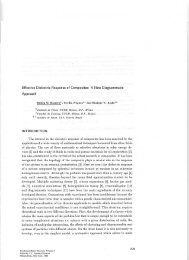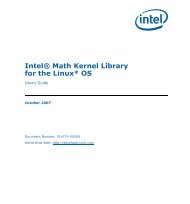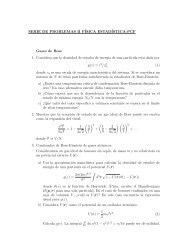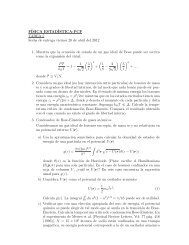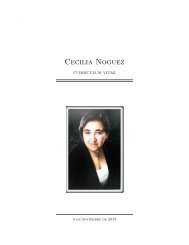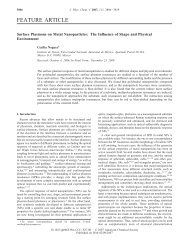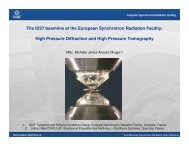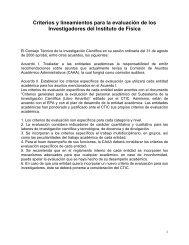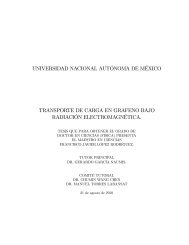Absolute values of transport mean free path of light in non-absorbing ...
Absolute values of transport mean free path of light in non-absorbing ...
Absolute values of transport mean free path of light in non-absorbing ...
Create successful ePaper yourself
Turn your PDF publications into a flip-book with our unique Google optimized e-Paper software.
258 J. GALVAN-MIYOSHI AND R. CASTILLO<br />
sured by compar<strong>in</strong>g the system transmittance with that <strong>of</strong><br />
calibrated suspensions <strong>of</strong> latex spheres <strong>in</strong> water where l ∗ is<br />
known [1,4,5]. There are just a few experimental procedures<br />
to determ<strong>in</strong>e l ∗ without us<strong>in</strong>g a reference sample. Mitani<br />
et al. [6] used coherent backscatter<strong>in</strong>g, Weitz and P<strong>in</strong>e [1]<br />
used pulsed DWS where l ∗ is estimated by measur<strong>in</strong>g the delay<br />
time <strong>of</strong> a signal due to the multiple scatter<strong>in</strong>g. Garcia<br />
et al. [7] developed a procedure where microwave radiation<br />
power is measured <strong>in</strong> the forward scatter<strong>in</strong>g geometry, us<strong>in</strong>g<br />
boundary conditions so that reflected waves from an <strong>in</strong>tegrat<strong>in</strong>g<br />
cavity can be neglected.<br />
In this paper, we present a procedure to obta<strong>in</strong> absolute<br />
<strong>values</strong> <strong>of</strong> the <strong>transport</strong> <strong>mean</strong> <strong>free</strong> <strong>path</strong> <strong>of</strong> <strong>light</strong> <strong>in</strong><br />
<strong>non</strong>-absorb<strong>in</strong>g media made <strong>of</strong> a colloidal suspension <strong>of</strong><br />
polystyrene microspheres. In this procedure, the basic issue<br />
is to measure the transmission and the reflectance <strong>of</strong> the<br />
colloidal suspension under study us<strong>in</strong>g an <strong>in</strong>tegrat<strong>in</strong>g sphere.<br />
We determ<strong>in</strong>ed how accurate our method was by compar<strong>in</strong>g<br />
our results with calculations made for colloidal suspensions<br />
<strong>of</strong> particles us<strong>in</strong>g Mie scatter<strong>in</strong>g theory and with experimental<br />
measurements made <strong>in</strong> colloidal suspensions us<strong>in</strong>g diffusive<br />
wave spectroscopy. The agreement is excellent.<br />
1.1. Transport <strong>mean</strong> <strong>free</strong> <strong>path</strong><br />
In this section, we present the basic equations to obta<strong>in</strong> l ∗<br />
from transmittance and reflectance measurements carried out<br />
<strong>in</strong> turbid <strong>non</strong>-absorb<strong>in</strong>g samples made <strong>of</strong> colloidal particles<br />
dispersed <strong>in</strong> a fluid, us<strong>in</strong>g an <strong>in</strong>tegrat<strong>in</strong>g sphere as shown <strong>in</strong><br />
Fig. 1. The system is conta<strong>in</strong>ed <strong>in</strong> a rectangular cell with parallel<br />
w<strong>in</strong>dows. Here, a collimated <strong>light</strong> <strong>of</strong> power P 0 is sent<br />
to an <strong>in</strong>tegrat<strong>in</strong>g sphere with an <strong>in</strong>ternal Lambertian surface.<br />
Light is collected by a detector placed on the wall <strong>of</strong> the <strong>in</strong>tegrat<strong>in</strong>g<br />
sphere, <strong>in</strong> the follow<strong>in</strong>g conditions: one with no sample<br />
at entrance and reflectance ports (beam strik<strong>in</strong>g directly<br />
on the sphere wall), one <strong>in</strong> transmission geometry (sample at<br />
entrance port, shown <strong>in</strong> Fig. 1) and one <strong>in</strong> reflection geometry<br />
(sample at reflection port). As we shall show from these<br />
measurements, by tak<strong>in</strong>g <strong>in</strong>to account the transmission and<br />
reflectance <strong>of</strong> the cell walls, it is possible to obta<strong>in</strong> reliable<br />
<strong>values</strong> <strong>of</strong> l ∗ .<br />
FIGURE 1. Schematic diagram <strong>of</strong> the <strong>in</strong>tegrat<strong>in</strong>g sphere with an<br />
amplification show<strong>in</strong>g the <strong>light</strong> transmittances along the cell walls<br />
and sample, from outside to the <strong>in</strong>tegrat<strong>in</strong>g sphere.<br />
1.1.1. Transmittance and reflectance <strong>of</strong> a fluid sample obta<strong>in</strong>ed<br />
us<strong>in</strong>g an <strong>in</strong>tegrat<strong>in</strong>g sphere<br />
To obta<strong>in</strong> the transmittance T ∗ <strong>of</strong> a turbid colloidal suspension,<br />
we need to analyze the transmission and reflection <strong>of</strong><br />
<strong>light</strong> when the suspension is placed <strong>in</strong> two different configurations:<br />
at the entrance port and at the reflection port <strong>of</strong> an<br />
<strong>in</strong>tegrat<strong>in</strong>g sphere. The transmitted or the reflected <strong>light</strong> from<br />
the sample is multiply reflected by the surface <strong>of</strong> the <strong>in</strong>tegrat<strong>in</strong>g<br />
sphere before reach<strong>in</strong>g the detector. The collected <strong>light</strong><br />
is a function <strong>of</strong> the <strong>in</strong>cident power and <strong>of</strong> the geometric and<br />
reflection parameters <strong>of</strong> the sphere. Picker<strong>in</strong>g et al. [8, 9]<br />
studied just this problem, so we shall use their derivation to<br />
obta<strong>in</strong> some <strong>of</strong> our work<strong>in</strong>g equations. For transmittance, the<br />
, is given by:<br />
collected power at the detector, P T d<br />
P T d = δ<br />
A<br />
�<br />
mAeff Tcd<br />
1 − [r δ<br />
A + mAeff + Rd(s ′′ /A)]<br />
�<br />
P 0T . (1)<br />
When the sample is <strong>in</strong> reflection geometry, <strong>light</strong> first strikes<br />
the <strong>in</strong>tegrat<strong>in</strong>g sphere, thus, diffuse <strong>light</strong> irradiates the sample.<br />
The collected power, P R d , at the detector can be expressed<br />
as:<br />
�<br />
�<br />
m<br />
P 0R . (2)<br />
P R d = δ<br />
A<br />
1 − [r δ<br />
A + mAeff + Rd(s ′ /A)]<br />
In these equations, P 0T and P 0R are the <strong>in</strong>cident powers, δ<br />
is the area <strong>of</strong> the detector, m is the reflection factor <strong>of</strong> the<br />
sphere wall, Rd is the diffuse reflection factor <strong>of</strong> the sample<br />
for diffuse <strong>in</strong>cident <strong>light</strong>, s ′′ and s ′ are the areas <strong>of</strong> the<br />
transmission and reflection ports, respectively. A is the total<br />
area <strong>of</strong> the sphere, Tcd is the diffusive transmission factor <strong>of</strong><br />
the sample for collimated <strong>in</strong>cident <strong>light</strong> (sample <strong>in</strong>clud<strong>in</strong>g the<br />
cell walls), Aeff = 1 − (δ/A + d/A + h/A) is the area fraction<br />
<strong>of</strong> the sphere wall relative to the total sphere area, h is<br />
the area <strong>of</strong> the sphere open holes, and d is s ′′ or s ′ depend<strong>in</strong>g<br />
on the measurement type. A baffle between the entrance port<br />
and the detector was considered and the term rδ/A was not<br />
neglected as it was <strong>in</strong> Picker<strong>in</strong>g et al. [8]. Equations 1 and 2<br />
can be rewritten <strong>in</strong> the follow<strong>in</strong>g manner:<br />
and<br />
where<br />
and<br />
Rev. Mex. Fís. 54 (3) (2008) 257–264<br />
P T d = b Aeff Tcd<br />
P<br />
1 − cRd<br />
0T , (3)<br />
1<br />
P R d = b<br />
1 − cRd(s ′ /s ′′ )] P 0R , (4)<br />
b = δ<br />
�<br />
m<br />
A 1 − � r δ<br />
�<br />
�<br />
A + mAeff<br />
c = s′′<br />
�<br />
1<br />
A 1 − � r δ<br />
�<br />
� .<br />
A + mAeff




